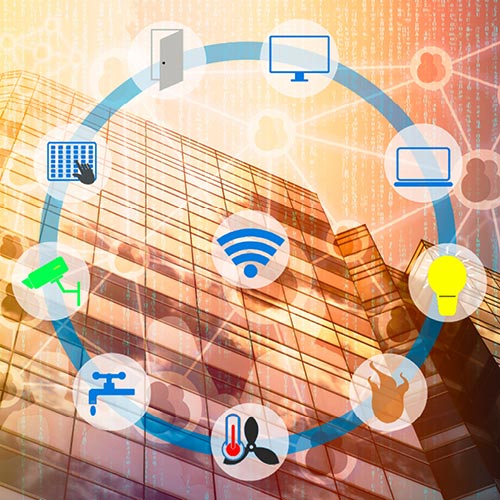Smart building trends to come: why a universal connectivity grid is a must-have
Today’s smart buildings are complex, network-heavy places that are going to become increasingly connected. Tenants’ current expectations typically include data connectivity everywhere in a building, access to power wherever they are, and flexibility and reliability in their chosen space. Here are a few trends you’re going to see in the smart building space and our recommendation on how you can deliver them all seamlessly and effectively.
Smart buildings have been around for a while, but COVID-19 prompted a bit of a rethink about what systems might be most important in a smart building moving forward. The goals of a smart building have typically centered on cutting costs, enhancing productivity, and driving environmental, social and governance (ESG) practices. That’s shifted a little in the past year or so, as the pandemic pushed health and safety considerations to the top of the smart building agenda. So that’s something else you now have to factor in.
Here are some thoughts about the systems and solutions you’ll need to prioritize in your smart building as we move forward.

- Real-time energy monitoring and usage forecasting. The days of opening an envelope, seeing how much electricity you’d used that month, and experiencing billshock are long gone. Today’s smart building systems let you review energy usage figures in real time, and can alert you of ways you might save money that month. Smart building systems are also able to forecast your future energy usage and help you make budget adjustments. Good for both cost-cutting and the environment.
- Occupancy-based HVAC sensors and controls. Old, manual, heating, ventilation and air conditioning (HVAC) systems are famous for consuming too much energy. They’re also well known for their inability to change settings based on building occupancy. So, no matter if there’s nobody in the building, if you’ve set your HVAC to maximum that morning, it will just waste energy until you change it manually again. In a smart building, connected sensors can communicate with your building’s HVAC control system in real time to give you genuine occupancy-based HVAC control.
- Air quality control. Another advantage of a building being networked and connected throughout all its systems is that you can use the smart HVAC to monitor and improve air quality. Connected sensors throughout the building detect humidity and heat, as well as the presence of gases like oxygen, nitrogen or carbon dioxide, and enable the HVAC system to take action. Say a sensor detects a high level of heat coming from a specific meeting room; your smart system could quickly increase air flow into that room and alert you to the issue.
- Energy use optimization. An intelligent HVAC control system can also turn off your building’s ventilation completely when the building is empty, and turn it up as and when the building’s occupancy requires. It can also detect underperforming or malfunctioning hardware in your building that need replacing—helping you save energy again.
- Connected access systems and door locks. This is another smart building feature that is expected to grow in importance as people return to workplaces post-COVID-19. Internet of things (IoT)-connected access systems and automated door locks let you provide tenants with a safer, more secure office building, and offer keyless, contact-free access.
These are just a few of the trends you can expect to see increase in importance and demand from tenants moving forward. And that’s before you factor in the hundreds of connected devices like smartphones, laptops, tablets, audio-visual equipment and more that make up the average office environment today. And also, before you consider that, the next must-have smart building technological innovation will certainly require network connectivity too.
How do you connect all this without making a mess?
If it sounds to you like all these systems, objects and devices will need a lot of network connectivity and cabling to enable them, you’re right! However, a universal connectivity grid (UCG) can give you the answers you need. A UCG is a converged infrastructure specifically designed to support all your real estate, facilities and IT services—all in a single, tidy and organized architecture. A UCG lets you connect every user, system and device in your building, whether they are static or on the move, and do it as unobtrusively as possible.
With a UCG you can deploy cable infrastructure throughout a workspace, with flexibility and scalability built in—to make sure the space is future-ready and can handle scaling up or down of tenant demands. A UCG does this by dividing your building’s floor space into evenly sized areas called “cells.” You then deploy consolidation points (CPs) in the ceilings of each cell, nicely hidden out of sight, and ready to deliver easy connections to the core network. Run a Category 6A cable from the CP and you can modify the building’s wired LAN, wireless technologies, IoT sensors, smart lighting, audiovisual kit, or access controls, quickly and easily.
A UCG also lets you streamline workstation moves, adds, changes and upgrades, and uses less resources and labor than a traditional design to do so. So, you’ll spend less time and money on managing your building, and you’ll have happier tenants: 1) their workdays aren’t disrupted by engineers shifting cables around the office and 2) they have a nicer, safer, healthier work environment in general.
The worldwide smart building market is forecast to grow from $68 billion in 2021 to $265 billion in 2028, at a compound annual growth rate (CAGR) of 21.6 percent1. Tenants certainly deserve connected systems and a smart environment from their building providers. A UCG can ensure you can give them that and also give you a competitive differentiator over your rivals.
1 https://www.fortunebusinessinsights.com/industry-reports/smart-building-market-101198
Universal connectivity grid (UCG): the Fact File
All you need to know about universal connectivity grid and how it delivers the power and connectivity your building’s nervous system needs




